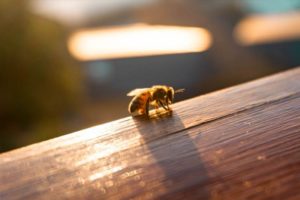Katherine K. Schlosser is an author and lecturer on native plants and herbs. Despite her allergy to honeybees, wasps, hornets, and yellow jackets, she spends most of her professional and personal life outdoors. In this post, Katherine shares her story. She artfully describes discovering a bee sting allergy and all the ways she keeps herself safe. It’s so vital that she continues doing what she loves, without fear. A stinging insect allergy doesn’t have to keep you indoors.
Here’s Katherine’s story.
Before I Discovered by Bee Sting Allergy
The story of my experiences with stinging insects is like that of many others: an uneventful early sting, a more severe sting to a younger brother that was soon forgotten, and an unexpected sting as an adult with a reaction that was fast and furious. My experience was a surprise that, thankfully, was treated quickly. A recommendation for venom immunotherapy has allowed me to move forward with little change to my routine.
According to the Journal of Asthma and Allergy, between 5 and 8 percent of people will experience a severe allergic reaction to an insect sting. The risk among beekeepers is as much as 32 percent.
Fearless Childhood
Late summer and early autumn are pleasant days for picnics, memories of which I carry from childhood. On my mother’s side, all of our relatives eagerly took to mountains and meadows with picnic baskets loaded. Neither tables nor chairs were required, only a pleasant shady spot, preferably with a stream alongside, blankets to sit on, and plenty of food. Cloud watching, wildflower collecting, and a little gossiping filled the sunny days, with children free to roam and dream. Unwelcome were stinging insects. I don’t recall being bothered by bees, wasps, hornets, or yellow jackets much, and only being stung once as a child by a honeybee. I was running barefoot in our backyard and was stung, I presume, by a honeybee on the clover. It was painful, but an icy popsicle soon distracted me from the torment. My younger brother, John, was stung the same summer, with his entire leg swelling and itching. A popsicle did not distract him, and decades ago, a trip to the doctor was unheard of for a bee sting. He recovered after a miserable couple of days. After that, bees were off my radar, other than as another pest to swat away.Mildly Cautious Adult
As an adult with children of my own, I paid more attention to stinging insects. Realizing that picnics, especially in autumn, could be disastrous, I took care to keep foods covered and beverages in clear containers–the better to see thirsty yellow jackets! Then, as a Scout leader, I was responsible not only for my children but also for others’ children. In all those years, we didn’t suffer a single sting.Systemic reactions to stings range from mild (pain and swelling at the sting site) to life-threatening (hives and itching all over the body, difficulty swallowing and breathing, decrease in blood pressure). Severe reactions require immediate medical attention. It has been estimated that there are 100 deaths a year from bee stings, though the number is presumed to be a severe underestimate as some deaths may be attributed to heart attacks, sunstroke, and other causes.

AN AWAKENING ENCOUNTER: DISCOVERING MY BEE STING ALLERGY
Out in my front yard, to pull a weed or two, I wore flip-flops (yes, I know that’s a no-no among gardeners). My husband sat nearby with the dog. Then I stepped into a bed next to a lovely Rhododendron periclymenoides, Pinxter Azalea, in full bloom. Immediately, a yellow jacket stung my foolishly exposed big toe. It was a surprise attack, and I shouted out an “ouch!” loud enough for my husband to hear. He came running.
I quickly explained I had seen the perpetrator fly away — certain she had a grin on her face.
Immediate Reaction
I went inside to find something to ease the sting when I noticed the palms of my hands beginning to itch. “Odd,” I thought and continued with my task. I entered the kitchen and felt my ears itching. Even odder, I thought. Getting the ice out and a cloth to wrap it in, with hands and ears itching, the top of my head began to itch. I noticed large, red, swollen splotches over my arms and body. Uh-oh. I still didn’t acknowledge what was happening and didn’t recall my brother’s incident many years earlier, but I knew something was wrong.
I headed back outside, where my husband and the dog waited for me. By the time I got out there, I could barely get an intelligible word out. My husband insisted that we get into the car and head for the emergency room, not more than a couple of miles away (I now know we should have called an ambulance!).
Emergency Care
In the emergency room, the young woman at the reception desk recognized my symptoms, and I bypassed all the usual check-in procedures. The triage nurses did the same, simply taking my temperature and blood pressure. They immediately took me back to see a doctor. This was an unusual experience, as prior emergency room visits were never so prompt. So, I got nervous, sensing I was in more danger than I thought.
I was lucky. It was only minutes before I received treatment (epinephrine, oxygen, intravenous antihistamines, and cortisone). The attending doctor, who was also allergic to bee stings, knew exactly what was going on and what to do. He carefully explained that the primary concern was swelling in my throat and lungs and that he would sit with me until he was sure he did not need to intubate me. He said intubation can assist with breathing, but intubation would not help if not caught in time, and the situation could be fatal. Timing is everything. For me, the medications flowing through kept me from needing that more extreme measure.

ALLERGY TESTING & VENOM IMMUNOTHERAPY TREATMENT
I left several hours later with a prescription for EpiPen® and a firm recommendation that I see an allergist for regular care. I followed that advice and have been on venom immunotherapy (one injection in each arm) every month for the past five years. Initial skin testing did not indicate a problem, but blood work showed reactions to honeybees, wasps, hornets, and yellow jackets.
The testing process was reasonably quick and easy, with answers in hand and a plan in place within a few weeks. Getting protection underway requires a commitment of time and persistence. I was to receive an injection for honeybees in one arm and another injection covering wasps, hornets, and yellow jackets in the other arm.
A New Normal After Discovering a Bee Sting Allergy
If I remember correctly, I went to the allergist’s office weekly for four months. Then I went every two weeks for a couple of months. And finally, I started going monthly, which I have been doing for five years. As you go through the process, the dosage is slowly increased from a very small dose to a full dose, allowing your body time to adjust without reacting. Each patient may have a different schedule depending on their allergies and their physician. Once started, if you miss a dose, you will have to repeat the prior dose/timing until you are back up to speed. Your physician’s staff keeps excellent records and will keep you properly protected. It is up to you to follow instructions closely and without missing appointments — your life may depend on it.
With such injections, many doctors require that you remain in the office for an hour in the beginning, then for 30 minutes after each injection. Thankfully, I am a reader, so it was a perfect time to catch up on the stack of books I always have waiting for me. At this point, they still recommend waiting in the office for 30 minutes, but I confess I rarely do that now. But I do go straight home, which is only 5 minutes away. I stay there until I am certain I will have no ill effects. I usually experience swelling at the injection site and considerably itching, but it is gone after one to three days.

LIVING WITH MY STINGING INSECT ALLERGY
Annual visits with the doctor are also required to assure that all is going well and that no adjustments need to be made to the dosage or schedule. They encourage replacing an EpiPen® immediately after use and annually if you have not. Each prescription comes with two functioning pens (sometimes one injection isn’t enough, so if help hasn’t arrived, use the other one following instructions with the pens) and one test pen that can be used repeatedly, so you and any family member understand how, where, and when to use them. They do not require refrigeration, but do not keep them in a car that will get hot in the sun.
Staying Safe
If I am hiking or doing fieldwork (for the conservation of endangered, threatened, and special concern native plants), I wear a vest with many pockets in which I keep the EpiPens®, my phone, emergency contacts names/phones, Benadryl, and information on the nearest emergency services. It sounds like a lot, but it is a small price to pay to continue the work for which I have a passion.
My husband and I love traveling the U.S., especially the Southwest and Northwest. We are often away from home for five or six weeks at a time. The way I handle injections, in that case, is to adjust my monthly schedule gradually, so I get my injections just before I leave town. Then, as soon as I get back, I run into the office and, if necessary, adjust my schedule to again receive monthly appointments. It helps to have a physician and staff who are willing to work with you, and I’m sure most will do so. Just ask.
Doing What I Love After Discovering a Bee Sting Allergy
Ordinarily, I would be allowed to stop the injections now. But since I am a gardener, and I volunteer in the field doing plant conservation work on isolated preserves around the state, I am often in areas with bees, wasps, hornets, and yellow jackets. There is no one within miles to help me. I love being in the outdoors, especially in areas where there are few, if any, people around. But it means I have to be careful and be prepared. Many of these places also have no or very weak phone signals, so having someone with me and an EpiPen® close at hand is essential.
So, too, it is a reasonable caution to continue the venom immunotherapy until I am too old to continue the work I love and that I hope makes a difference in our world. At that point, I feel sure I will be relatively safe working around our home without the need to continue with the injections. I will certainly be close enough to emergency services to get the help I might still need.
I am cautious. Such simple things, in addition to the immunotherapy, like letting people know where I am going, being aware of the closest help available (ambulances, fire departments, police or sheriff’s offices), and keeping EpiPens® and Benadryl within reach free me from paralyzing fear. The bees and I can live together, much as humankind has done since we came into existence.

Katherine K. Schlosser
Author and lecturer on native plants and herbs; a naturalist and conservationist.
The views, information, or opinions expressed in this blog are solely those of the author.






